ASRock Fatal1ty Z77 Professional Review - IDE and Floppy on Z77
by Ian Cutress on May 20, 2012 1:30 PM EST- Posted in
- Motherboards
- ASRock
- Fatal1ty
- Z77
USB Speed
For this benchmark, we run CrystalDiskMark to determine the ideal sequential read and write speeds for the USB port using our 240 GB OCZ Vertex3 SSD with a SATA 6 Gbps to USB 3.0 converter. Then we transfer a set size of files from the SSD to the USB drive using DiskBench, which monitors the time taken to transfer. The files transferred are a 1.52 GB set of 2867 files across 320 folders – 95% of these files are small typical website files, and the rest (90% of the size) are the videos used in the Sorenson Squeeze test.


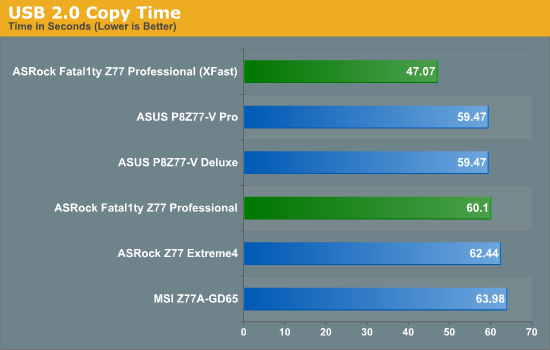
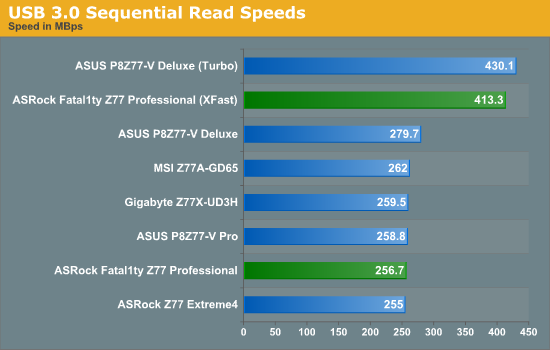
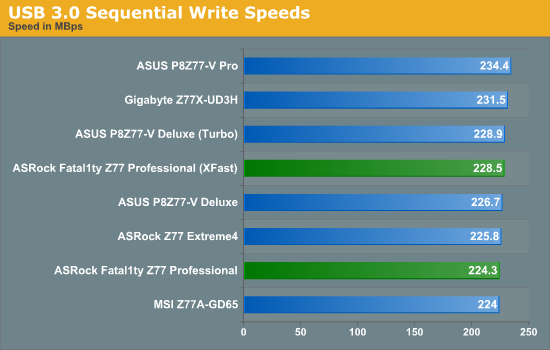

While the XFast implementation clearly makes the ASRock pull ahead of all the standard solutions of other motherboards, the default performance of the ASRock is a little disappointing. The USB 2.0 results in particular, as all the other manufacturers have at least another 1 MBps read speed on the ASRock implementation.
SATA Testing
We also use CrystalDiskMark for SATA port testing on a C300 drive. The sequential test (incompressible data) is run at the 5 x 1000 MB level. This test probes the efficiency of the data delivery system between the chipset and the drive, or in the case of additional SATA ports provided by a third party controller, the efficiency between the controller, the chipset and the drive.
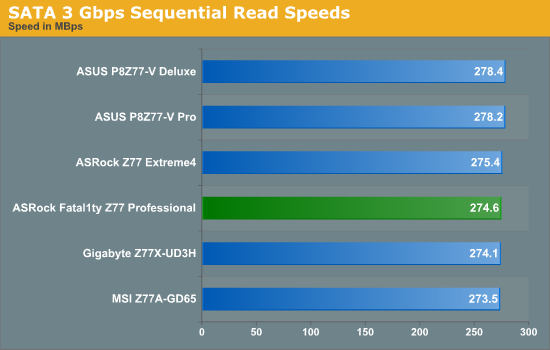
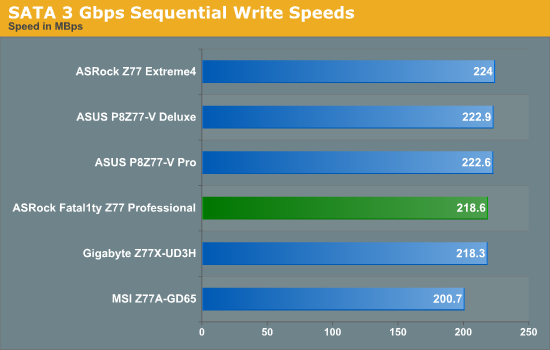
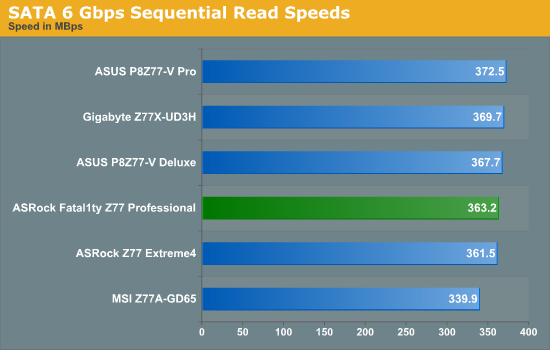
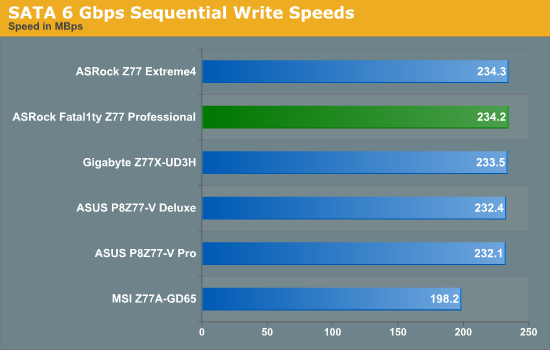
Nothing much to compare with regards to the SATA implementations between the boards.
DPC Latency
Deferred Procedure Call latency is a way in which Windows handles interrupt servicing. In order to wait for a processor to acknowledge the request, the system will queue all interrupt requests by priority. Critical interrupts will be handled as soon as possible, whereas lesser priority requests, such as audio, will be further down the line. So if the audio device requires data, it will have to wait until the request is processed before the buffer is filled. If the device drivers of higher priority components in a system are poorly implemented, this can cause delays in request scheduling and process time, resulting in an empty audio buffer – this leads to characteristic audible pauses, pops and clicks. Having a bigger buffer and correctly implemented system drivers obviously helps in this regard. The DPC latency checker measures how much time is processing DPCs from driver invocation – the lower the value will result in better audio transfer at smaller buffer sizes. Results are measured in microseconds and taken as the peak latency while cycling through a series of short HD videos - under 500 microseconds usually gets the green light, but the lower the better.

The DPC timings on Ivy Bridge are exceptional – not one board has yet achieved slower than 120 microseconds. The Fatal1ty puts in a good show, just missing out on a sub 100-microsecond timing.










57 Comments
View All Comments
SlyNine - Monday, May 21, 2012 - link
It's not pointless at all. Because you don't know wtf you're talking about or what I use my stuff for.f4phantom2500 - Monday, May 21, 2012 - link
clearly you're looking for a flame war, noting twice that you needed to use a fuckload of hard drives without stating why, then jumping some guy's shit when he points out the impracticality of it, again without stating why...but don't worry man i'm sure you're too busy saving the world with your 10 hard drives and shitty internet to be bothered to explain your master plan to a simpleton like assball or myself.SlyNine - Saturday, May 26, 2012 - link
LOL whatever you say. Like we all have a choice on where we live or our ISP. So somehow because I don't share details of my setup with you im instigating a flame war. Weird logic.If anything you're adhominem attack is instigating some flame war.
I have a media server...seems like kind of a DUH statement, as thats the most likely thing someone would use that many HDDs for. I take blu-rays (about 250 so far), demux and remux them in to MKVs and I have about 2 TB of lossless music. Plus I have a lot of shows. It makes sense, since I have a crappy internet and streaming isn't practical, not that I want someone to control my media anyways.
DJMiggy - Monday, May 21, 2012 - link
My LCD makes my crappy internet better as well.... Wait WHAT?Dark_Eternal - Tuesday, May 22, 2012 - link
I'm pretty sure he meant that he doesn't play FPS games online anymore because his Internet connection is slow and LCDs are too laggy for him. Even though he did sound really angry. :PSlyNine - Saturday, May 26, 2012 - link
Yea, it doesn't make me happy lol.SlyNine - Saturday, May 26, 2012 - link
Wait you got "My LCD makes my crappy internet better as well.... " out of "To bad I moved to a place with crappy internet, and was forced to buy a LCD."?Seems pretty clear, I use to have a good internet and good CRT, but because I had to sacrifice both of them my gaming suffered.
SlyNine - Sunday, May 20, 2012 - link
nt.LeftSide - Sunday, May 20, 2012 - link
Thanks for the post times! This will be such a great benefit when I decide to upgrade my HTPC. Plus, shining light on post times gives MB manufactures incentive to increase performance!ShieTar - Sunday, May 20, 2012 - link
"One interesting novel setting that ASRock now have is the ‘Dehumidifier Function’."Is there any justification why this is labeled as dehumidifier? Is this supposed to be relevant for people with leaky water cooling systems that run up a significant relative humidity inside their cases? Without a source of humidity inside the case, there is no reason why the air that was pulled in at room temperature should suddenly have a higher humidity after cooling down to room temperature again.
Or is this setting still exactly as useless as it was a few years back when some company tried to sell it as an "overheating at switchoff" protection?